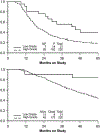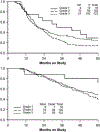Reclassification of serous ovarian carcinoma by a 2-tier system: a Gynecologic Oncology Group Study
- PMID: 22072418
- PMCID: PMC11809296
- DOI: 10.1002/cncr.26618
Reclassification of serous ovarian carcinoma by a 2-tier system: a Gynecologic Oncology Group Study
Abstract
Background: A study was undertaken to use the 2-tier system to reclassify the grade of serous ovarian tumors previously classified using the International Federation of Gynecology and Obstetrics (FIGO) 3-tier system and determine the progression-free survival (PFS) and overall survival (OS) of patients treated on Gynecologic Oncology Group (GOG) Protocol 158.
Methods: The authors retrospectively reviewed demographic, pathologic, and survival data of 290 patients with stage III serous ovarian carcinoma treated with surgery and chemotherapy on GOG Protocol 158, a cooperative multicenter group trial. A blinded pathology review was performed by a panel of 6 gynecologic pathologists to verify histology and regrade tumors using the 2-tier system. The association of tumor grade with PFS and OS was assessed.
Results: Of 241 cases, both systems demonstrated substantial agreement when combining FIGO grades 2 and 3 (overall agreement, 95%; kappa statistic, 0.68). By using the 2-tier system, patients with low-grade versus high-grade tumors had significantly longer PFS (45.0 vs 19.8 months, respectively; P = .01). By using FIGO criteria, median PFS for patients with grade 1, 2, and 3 tumors was 37.5, 19.8, and 20.1 months, respectively (P = .07). There was no difference in clinical outcome in patients with grade 2 or 3 tumors in multivariate analysis. Woman with high-grade versus low-grade tumors demonstrated significantly higher risk of death (hazard ratio, 2.43; 95% confidence interval, 1.17-5.04; P = .02).
Conclusions: Women with high-grade versus low-grade serous carcinoma of the ovary are 2 distinct patient populations. Adoption of the 2-tier grading system provides a simple yet precise framework for predicting clinical outcomes.
Copyright © 2011 American Cancer Society.
Conflict of interest statement
CONFLICT OF INTEREST DISCLOSURES
The authors made no disclosures.
Figures




References
-
- Baak JP, Delemarre JF, Langley FA, Talerman A. Grading ovarian tumors. Evaluation of decision making by different pathologists. Anal Quant Histol. 1986;8:349–353. - PubMed
-
- Bertelsen K, Holund B, Anderson E. Reproducibility and prognostic value of histologic type and grade in early epithelial ovarian cancer. Int J Gynecol Cancer. 1993;3:72–79. - PubMed
-
- Shimizu Y, Kamoi S, Amada S, Akiyama F, Silverberg SG. Toward the development of a universal grading system for ovarian epithelial carcinoma: testing of a proposed system in a series of 461 patients with uniform treatment and follow-up. Cancer. 1998;82:893–901. - PubMed
-
- Winter WE III, Maxwell GL, Tian C, et al. Prognostic factors for stage III epithelial ovarian cancer: a Gynecologic Oncology Group Study. J Clin Oncol. 2007;25:3621–3627. - PubMed
-
- Malpica A, Deavers MT, Lu K, et al. Grading ovarian serous carcinoma using a 2-tier system. Am J Surg Pathol. 2004;28:496–504. - PubMed
Publication types
MeSH terms
Grants and funding
LinkOut - more resources
Full Text Sources
Medical

